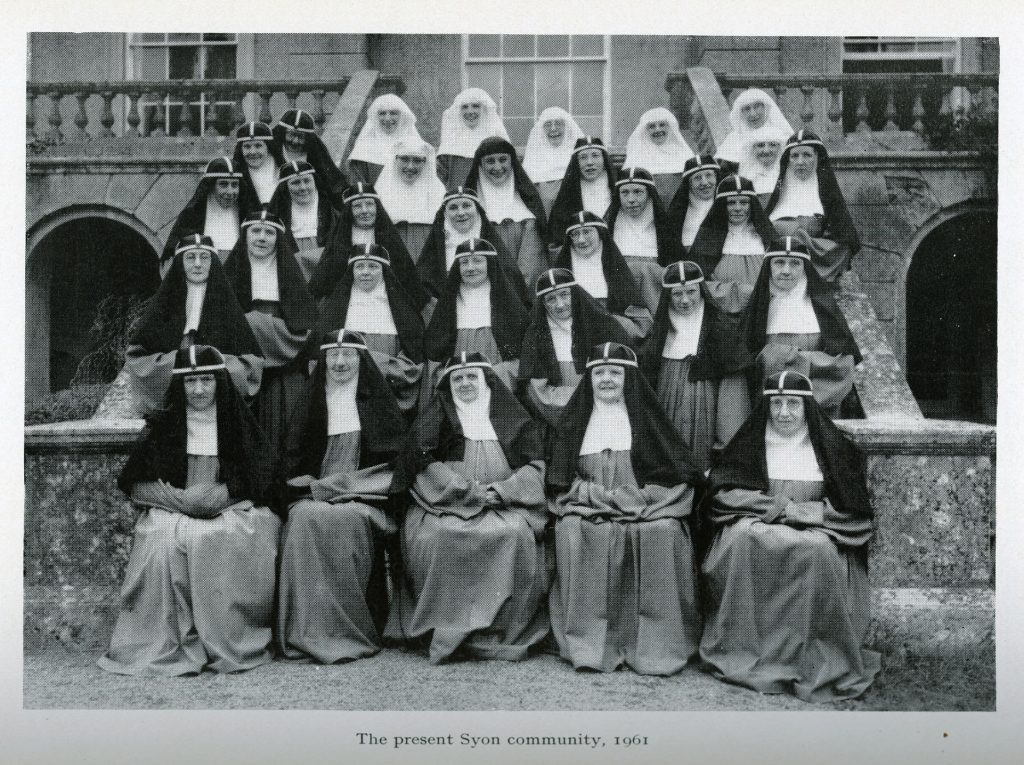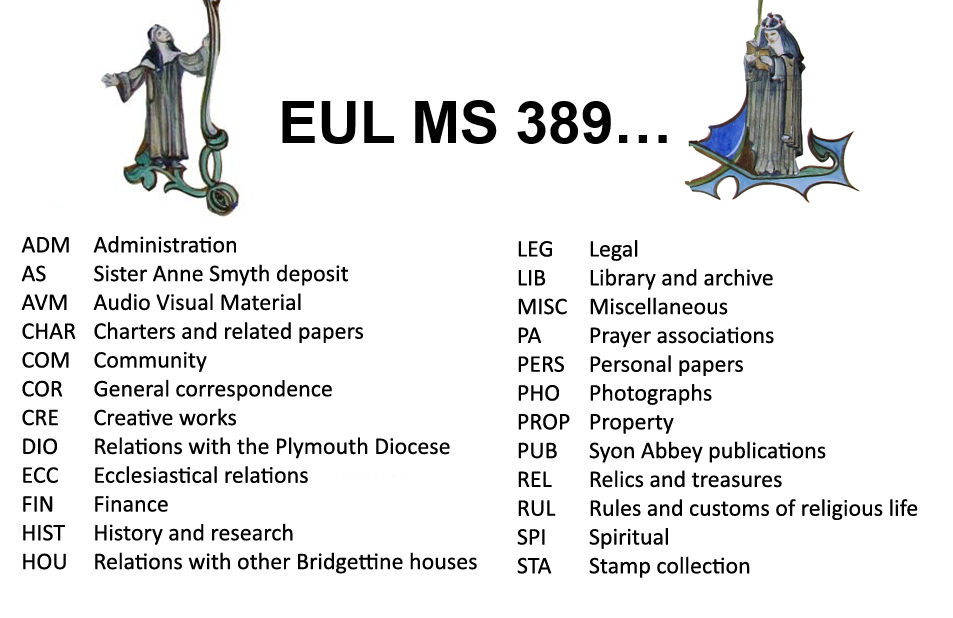Hello everyone, and a very warm welcome to this blog.
My name is Annie and I joined the team in November 2016 as the project archivist for the Syon Abbey Archive.
Syon Abbey was a monastic house of the Order of the Most Holy Saviour (also known as the Bridgettines), and the only English community of religious to have existed without interruption since before the Reformation. The house was founded directly from the Mother House in Vadstena in Sweden in 1415, and the community followed the Rule of St Bridget of Sweden. This enclosed Bridgettine community – comprising both nuns and monks and governed by an abbess – was renowned for its dedication to reading, meditation and contemplation. In the course of Syon Abbey’s almost 600-year history, the community faced great upheaval and demonstrated remarkable strength. In the wake of Henry VIII’s Dissolution of the Monasteries, the community split into smaller groups and continued their religious practice, with some remaining in England whilst others sought refuge abroad. Although Syon Abbey was restored in England under the Catholic rule of Mary I, following the accession of Elizabeth I and the return to Protestantism, the community went into exile. The community then spent over half a century wandering through the Low Countries and France, experiencing, at times, extreme poverty and hunger, and along the way encountering rioters, war, and even pirates. The community eventually found a new home in Lisbon in 1594 and remained there until 1861, at which time the sisters (the last brother of Syon Abbey having died in 1695) were able to return to England, initially residing in Spetisbury, Dorset. Following a further relocation in 1887 to Chudleigh, Devon, the community finally settled in South Brent, Devon in 1925. 86 years later, in 2011, on account of the decline in numbers and age of the remaining community, the decision was made to close Syon Abbey.
Of course, the archive – deposited for safekeeping with the University’s Special Collections in 2011 – has many more fascinating stories to tell from Syon Abbey’s extraordinary history than have been briefly summarised above. It currently spans around 114 boxes and comprises material from the 16th to the early 21st century, although the majority of records date from the 19th and 20th century. The archive is large and complex, containing a range of different records relating to daily life; worship; religious rule; the management of land, property and finances; relations with other religious communities; and much, much more. Once catalogued, the archive has the potential to be a rich and powerful resource, particularly for anyone interested in the history of women religious, ecclesiastical history, and women’s studies.
When I arrived, my first priority was to look at different material from the Syon Abbey archive and to learn as much as possible about the community and its history. This understanding then enabled me to draft out a hierarchical structure for the archive that reflects the main functions and activities of the community and provides context for how the records were originally used. Although an original order can be identified in several of the boxes in the archive – for example, some related papers have been kept together in chronological order – in other boxes the records are a little more jumbled up. Consequently, the arrangement of the archive that has existed up to now has meant that it would be difficult for both users (you!) and the archivist (me!) to find the information we are looking for within the archive and to understand how one record relates to another. My job as archivist on this project, therefore, is to arrange and describe the archive in a way that will make the records easier for you to search, find, understand and use.
Over the next year I will be re-boxing, cataloguing and promoting the archive, with an aim to make it more discoverable and accessible, and to encourage its use in teaching, learning and research. By the end of March 2018, the archive should be catalogued to at least file level, and be searchable using the online catalogue. I hope you will join me on this exciting journey as I share my progress, as well as highlights from the archive, with you via this blog and on Twitter @UoEHeritageColl.
Talk to you again soon!
By Annie, Project Archivist
Click here for more information on the Syon Abbey archive and other related collections.
Click here to search the University of Exeter’s archival collections via the online catalogue.
N.B. Thank you for reading! The Syon Abbbey archive cataloguing project was completed in June 2018. The archive can now be browsed on the online archives catalogue and archive material can be accessed in the Special Collections Reading Room.


I am researching Burrell( burel) family history. I would be very interested to know why people at Syon Abbey had a Rule to wear burel cloth.
Hello Martin, thanks for your comment! I’m afraid this isn’t something I’ve come across in the archive. However, I think I once read that the habits were made of burel, as it was a coarse material often worn by the poorer classes, and so fit in with the austere and humble way of life at Syon Abbey. Much has been written about the Bridgettine Rule and Syon Abbey in the medieval period, and a comprehensive bibliography of literature on Syon Abbey can be found at: https://syonabbeysociety.wordpress.com/sara-bibliography/.
Hi Annie, thanks for that information. Do you have any data on who the burel cloth was bought from?
Hello Martin! No, unfortunately as I mentioned before, I’ve never come across a mention of burel cloth in the Syon Abbey archive. Good luck with you research!
I live in Norwich. There was a Burrell family active in St Matthews church in Thorpe Hamlet until about twenty years ago. Anglican Church. I have a personal interest in the Carmelites and in French, the rough brown material used until the mid twentieth century for the female Carmelites is called “burre,” which must be from the same source word as burrell. I hope this helps your research. Best wishes. Peter Bevis
Thanks Peter. My research shows a Burel/Burrell connection. Norfolk seems to have been a popular place to live, but one of my gandfathers left Flitcham for a life at sea, then settled in Auckland NZ. Burre cloth has been added as another piece of my jigsaw puzzle. Any further data is very welcome – especially 1400 – 1550 Norfolk.
Hi, I am doing my family history and have recently found that a gt aunt of mine was a nun at Syon Abbey. I have her date of birth and death. I know she was at South Brent until her death in 1970. I am now interested to find out where she may have been buried, dont know if you can help please?
Thanks for you comment, Ann! I will send you an email. 🙂
Hi Annie,
I wonder if you have any documents in your collection which may relate to St Mary Magdalene’s Church in Barwick.
When the Churches of Yeovil were given to the Sister around 1418, the appropriated our little church very quickly for historical reasons. In 1440 they had 2 bells made for our church tower by William Chamberlain whose apprentices continued to use his Mark of three bells which Is still used today by the Whitechapel bell foundry. Do you know if any documentation from this period still exists? Sir John Horse oversaw their interests at Clifton Maybank which is a nearby village; do any documents of his still exist? We still have the bells although they now need conservation.
We also have a small fresco showing a nun blessing someone – I wonder if this is related to the Sisters also.
Can you point me in the right direction or help in any way?
Hi Annie
As per Ann – I’m putting together a family tree.
My great aunt is in the picture. She is in the second row, second from the left though, looking at the photo, it looks like she is third from the left. She isn’t wearing glasses, has a round face and is looking up to her right a bit. She stands immediately behind the nun sitting on Lady Abbess’s right – Lady Abbess is in the middle of the front row.
I know her as Winnie (Winifred Kelly – born 1901). I’d love any information you may have on her to keep building the tree.
I look forward to hearing from you. Thank you. Alex
Hi Alex, thank you very much for your comment! The Syon Abbey archive does indeed contain several records relating to Winifred Kelly, which I hope will help you with your family research. I’ll be in touch today via email with more information. Best wishes, Annie
I believe Winifred Kelly took the name Sister Catherine and was related to my father Thomas Cox.
Does that mean anything to you ?
I have fond memories of visiting Syon Abbey as a child.
Hello Catherine, thanks for your comment! The archive does indeed contain a few items relating to Sister Mary Katherine (Winifred) Kelly. I will send you an email with more information.